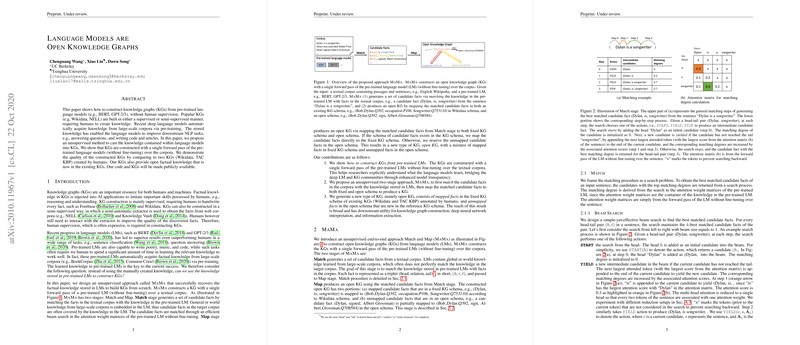Insightful Overview of "LLMs are \Open Knowledge Graphs"
The paper "LLMs are \Open Knowledge Graphs" articulates an innovative approach to constructing knowledge graphs (KGs) from pre-trained LLMs (LMs) such as BERT and GPT-2/3. The fundamental proposition of this paper is to extract knowledge from these LMs without relying on human supervision, which marks a significant shift from traditional supervised KG construction methods.
Methodology and Contributions
The methodology centers around the introduction of an unsupervised technique termed "Match and Map" (MaMa). This strategy involves two fundamental stages:
- Match Stage: Candidate facts are generated by matching text from a corpus with pre-trained LM knowledge. The technique leverages the attention mechanisms inherent in LMs to identify relationships between entities expressed as triplets (head, relation, tail). Beam search is employed to capture the most probable relationships without any fine-tuning.
- Map Stage: These candidate facts are mapped onto structured knowledge graphs. If candidate facts align with existing KG schemas (e.g., Wikidata), they are incorporated directly. Otherwise, they are added to an open schema allowing for knowledge expansion beyond current schemas.
A distinguishing feature of the proposed system is its ability to generate "open KGs." These incorporate both facts within existing KG structures and entirely new facts in open schemas, which are not covered by the existing knowledge bases.
Results and Evaluation
The paper highlights the potential of MaMa through rigorous evaluations against existing knowledge graphs, such as TAC KBP and Wikidata. Remarkable precision was evident in their output, with precision exceeding 60% in several cases, effectively outperforming existing systems like Stanford OpenIE and OpenIE 5.1. Recall capabilities, while lower, provide an avenue for future optimization, especially with larger and more diverse linguistic models.
Moreover, deeper and larger LMs like GPT-2 XL exhibit enhanced performance, suggesting that larger models embed richer and more complex knowledge structures. It’s crucial to note that BERT-based models demonstrated higher recall than their similarly-sized GPT-2 counterparts, indicating the efficacy of BERT’s masked LLMing.
Implications and Future Directions
The implications of extracting open KGs from LMs extend into various domains, primarily for knowledge expansion in AI applications, KG construction, and enhancing deep neural network interpretability. As demonstrated, MaMa can uncover "new-in-the-existing-KG" factual knowledge, broadening the useful scope of KGs.
Looking ahead, advancing this work involves improving recall and exploring the potential of even larger LMs, such as GPT-3 or Megatron-LM. There is also room for refining the alignment algorithms for better entity detection and relation mapping. Furthermore, integrating crowdsourcing evaluations or more sophisticated methods, such as graph neural networks, could enhance both the extraction precision and the understanding of the nuanced knowledge embedded in LMs.
In conclusion, this paper offers a compelling perspective on leveraging the stored knowledge in LLMs to construct and expand knowledge graphs, presenting annotated insights into the knowledge acquisition capacities of unsupervised LMs. This innovation could prove essential in bridging the gap between deep learning models and structured knowledge representation systems.
